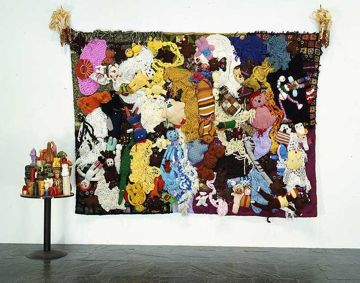
Two of my favorites in the Whitney Museum's Collecting Biennials show: Mike Kelley, "More Love Hours Than Can Ever Be Repaid" and "The Wages of Sin," both 1987
Sometimes certain quotes hit you in a way that make you think and rethink… Here’s one I came across recently from Mike Kelley in Press Play: Contemporary Artists in Conversation:
I think that the practice of art is an examination of visual communication. People have to recognize visual culture as a constructed language, a language that acquires meanings through its construction. The art viewer should not simply be a patsy who performs a set of knee-jerk responses in reaction to a set of visual conventions. Art should be more complex than that.
Kelley’s quote makes me think of two things.
First it makes me think about how often we’re in the position of playing the patsy. Rather than investigate work and come up with meaningful questions, we get sucked into a shopping mall culture of looking (vs. seeing) and deciding whether something is “good” or “interesting” (a word I’m disliking more every day since it’s often used as a cop out).
Second, it makes me think about Bruce Dorfman, a wonderful artist, teacher, and mentor I had at the Art Students League many years ago. He would talk about the difference between complexity vs. complication. Being complex can engage the viewer while being complicated can alienate. Complex work has layers to explore- layers of meaning and perhaps material. Complicated work leaves the viewer with too many questions and inevitably a shoulder shrug of indifference.
One of the challenges we face as artists and educators is to create and share work that is perhaps complex, but not too complicated. We also face the constant challenge of not playing the patsy in and out of the classroom. Modeling ways of engaging with works of art is part of a rounded art education, particularly in high school and college.



